deepeye.hu
Astronomical Drawings of Peter Kiss
Astronomical Drawings of Peter Kiss





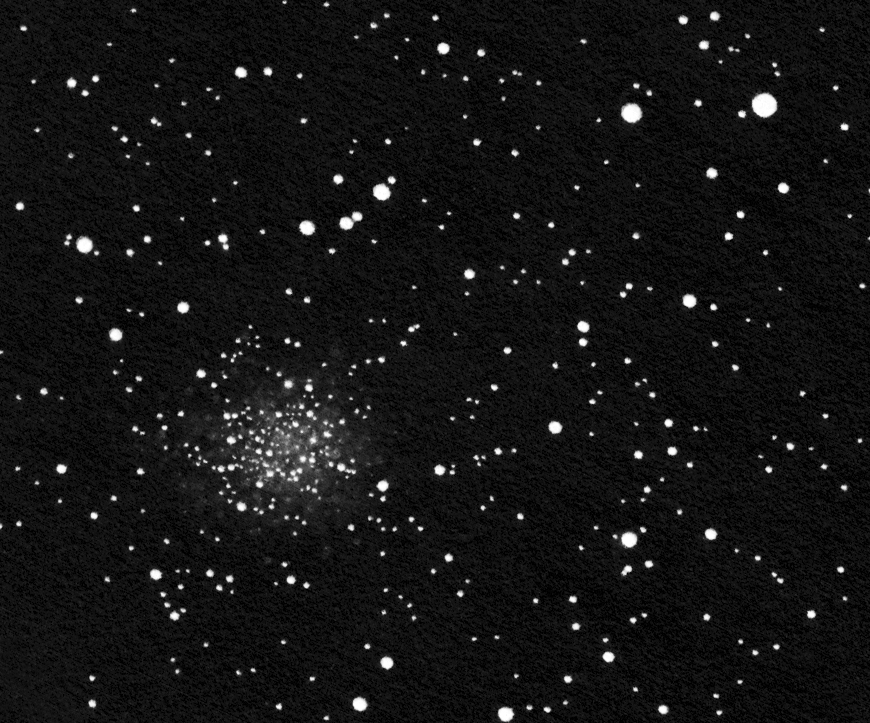
NGC 7789 is perhaps my favourite open cluster in the whole sky, including the southern part as well. It was I think in the summer camp of 1998 at Ágasvár that I was lying in my sleeping bag and wandering around in the summer and autumn Milky Way with a pair of 10x50 binoculars. Then this open cluster came into my field of view in the dense starfield next to ß Cas. At first I thought it was a comet - I couldn't see a single star in it. I love this cluster ever since. It is the most beautiful with smaller telescopes. Using larger scopes - completely resolved - it doesn't seem to be that very special.
I was nursing the thought of drawing this cluster for at least 10 years. At the beginning I thought this project to be impossible. Then I was thinking more about how I should do it: what enlargement should I use, how big the field should be, what should the composition look like. And I was waiting for the right moment. It came in the great hungarian astronomical camp of 2013 at Tarján. And I fortunately managed to finish the sketch the same year.
I can only talk about the cluster and the field - a shiny Milky Way field packed with stars - in superlatives. The open cluster is not ostentatiously bright and it doesn't contain extremely bright stars. But it has about 900 members according to the catalogue. Out of these I managed to draw about 50-80 by position. The whole cluster is a mottled glow in the small Dobsonian. Almost all of its stars are relatively faint.
From a scientific point of view the peculiarity of NGC 7789 is that it countains a relatively large number of blue stragglers. These are hot blue giant stars with an apparent age that is much younger than that of the other members. They probably took part in a binary star interaction. By comparing my drawing with a photo containing the blue stragglers it turned out that I drew many of them by position.
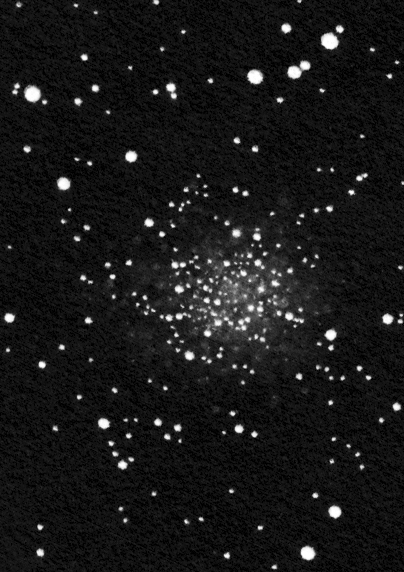
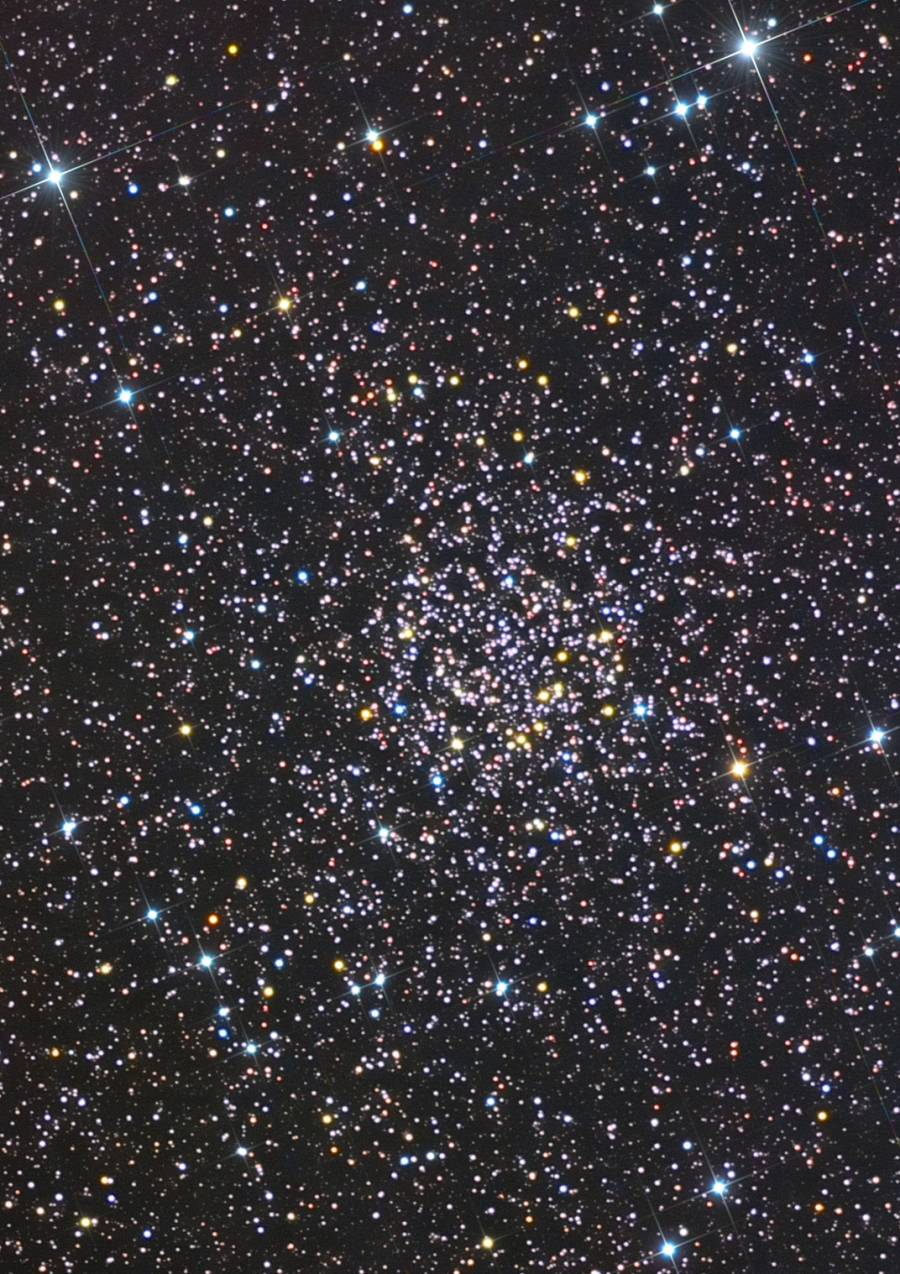
The photo on the left, courtesy of MTM Observatory Italy was made using a 15 cm telescope. The original photo has been rotated and cropped so that the inverted drawing and the photograph show a similar area of the sky.
It is a tedious task to compare open clusters because you really need to identify individual stars.
Since NGC 7789 is a special cluster to me I tried to draw it as precisely as I could. You can see the result which is not bad I think. Of course you can see the errors as well.
I could neither see the sea of faint stars nor the colors of the members. Nevertheless I think the visual impression is not really behind the photograph. It is especially worth comparing the string of red giants at the edge of the dense inner part of the cluster (to the lower right). Both the general impression and the individual stars are present in the drawing.
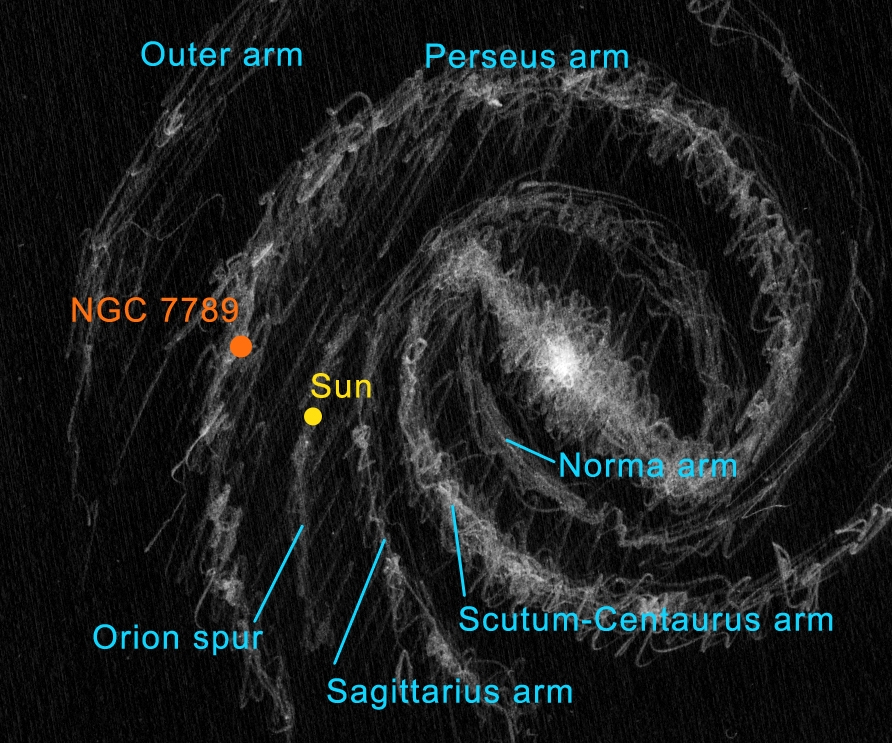
The open cluster NGC 7789 is about 7600 light years away from us in the Perseus arm of our Milky Way. It contains about 1000 member stars and we can find it in the constellation Cassiopeia. Its apparent size is about 20' and visual magnitude about 6.7mg. The brightest members - red giants and blue stragglers - are about 11mg. The cluster is about 1.6 billion years old (1.6 x 109 years) which makes it a relatively old open cluster.
NGC 7789 was discovered by Caroline Herschel in 1783 hence the name "Caroline's Rose".
The member stars were catalogued by F. Küstner in 1923[1]. So "K" in the name of the stars below is for Küstner.
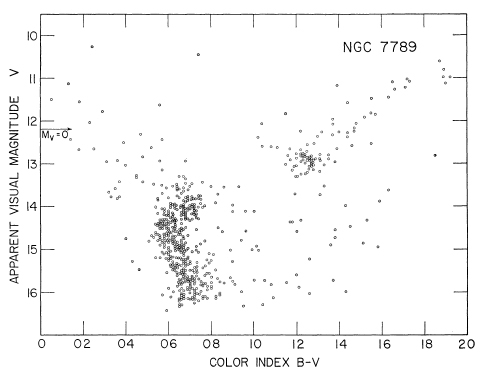
The stars of an open cluster are usually born simultaneously in a short period of time compared to the lifetime of the stars. Therefore the members of the cluster are about the same age - 1.6 billion years in the case of NGC 7789. But the masses of the stars are different therefore the members are at different stages of their life depending on their initial mass. Hidrogen fusion is in full swing in the cores of the smaller stars - they are on the main sequence of the Hertzsprung-Russel diagram (or the very similar color-magnitude diagaram). Proceeding (in thought) towards the stars with greater inital masses - moving top left on the main sequence of the color-magnitude diagram - we reach the turn off point. In the case of NGC 7789 this is around B-V = 0.6mg, V = 14mg according to the figure on the right. There is already not enough hidrogen in the core of the stars at the turn off point to keep the star in equilibrium using hidrogen fusion. Contrary to their greater initial mass these stars used up their "fuel" much faster than their smaller siblings. These stars will "rapidly" become red giants in the future (move top right in the color-magnitude diagram). All this has already happened for stars with even greater masses - they are red giants (top right in the color-magnitude diagram). And the stars with the greatest initial masses in the cluster have probably already exploded as supernovae.
If we take a careful look at the color-magnitude diagram of NGC 7789 we can see stars on the main sequence above the turn off point as well. These are hot bright blue stars which don't fit into the model described above. Since in case these had been formed at the same time as the rest of the cluster, they should already have exploded as supernovae. Blue stragglers were discovered by Allan Sandage in 1953 in the globular cluster M 3. And their very nature is not clear ever since.
Using proper motion, radial velocity and polarization studies it has been established that most probabaly a large number of the blue stragglers physically belong to the cluster. The latter measurement is based on the idea that the interstellar medium slightly polarizes the light of the stars which is initially approximately not polarized. In case a star lyies behind or in front of the cluster then its light passes through a different colum of interstellar dust and gas, therefore the degree and direction of its polarization may be different than that of the cluster members.
Spectroscopical studies didn't show blue stragglers to be any more special than average stars.
There was an idea that blue stragglers could have formed later in a second wave of star formation in the cluster. Or they could have been gravitationally captured by the cluster during its orbit around the center of the Milky Way. Observations do not support any of these hypotheses.
Blue stragglers are known to occur in young and old open clusters, globular clusters and in the halo of the Milky Way. And we are not talking about only a couple of stars. There are clusters which host a considerable number of blue stragglers. NGC 7789 is an example for this. Their spatial distribution in the cluster does not reveal their very nature either.
Ther are many models which try to explain the presence of blue stragglers. In case of single stars there was an idea that the star's mass is mixed (due to fast rotation for example). Hidrogen could get into the core of such stars and the star could spend more time on the main sequence. More recent and more precise measurements suggest however that the majority of blue stragglers are (or were) close - or even contact - binaries where there is mass transfer between the two components. Or the two stars might even coalesce. Or they might be stars formed by collisions of binary systems.
The discovery that some blue stragglers are spectroscopic binaries (with a period in the order of 1 day) supports the binary star hypothesis. It is possible that there are more ways to form blue stragglers. And it might change from cluster to cluster which method is dominant.
| Star (Küstner) | V [mg] | B-V [mg] | Seen (visible in the drawing) |
|---|---|---|---|
| K 282 | 12.05 | 0.27 | yes (?) |
| K 342 | 12.42 | 0.22 | probably |
| K 409 | 12.98 | 0.31 | yes (?) |
| K 453 | 12.66 | 0.25 | yes (?) |
| K 677 | 11.16 | 0.17 | yes |
| K 746 | 12.74 | 0.39 | probably |
| K 1211 | 11.55 | 0.17 | yes |
We don't need to solve one of the enigmas of astrophysics to get a little closer to blue stragglers. As it is visible in the color-magnitude diagram of NGC 7789 the blue stragglers are among the brightest cluster members - along with the red giants. Unfortunately I learned about the blue stragglers after I made my final drawing, therefore I was not aware what I was exacly seeing in the telescope. The brightness data of the blue stragglers depicted in my drawing are summarized in the table to the right. Most probably all of them are cluster members. There are a lot more (at least a dozen) blue stragglers in NGC 7789. But those are fainter (about 13mg-14mg).
As a curiosity the stars K 677 and K 1211 are so bright (and massive) that they are somewhere around the upper limit of the binary star hypotheses, thus complicating the astrophycicists' life.
As far as I know the blue stragglers of NGC 7789 have already been observed in Hungary by Gáspár Bakos who used a 4.3" Newtonian telescope. This observation could probably take place in the 1990's but I don't know any more details.

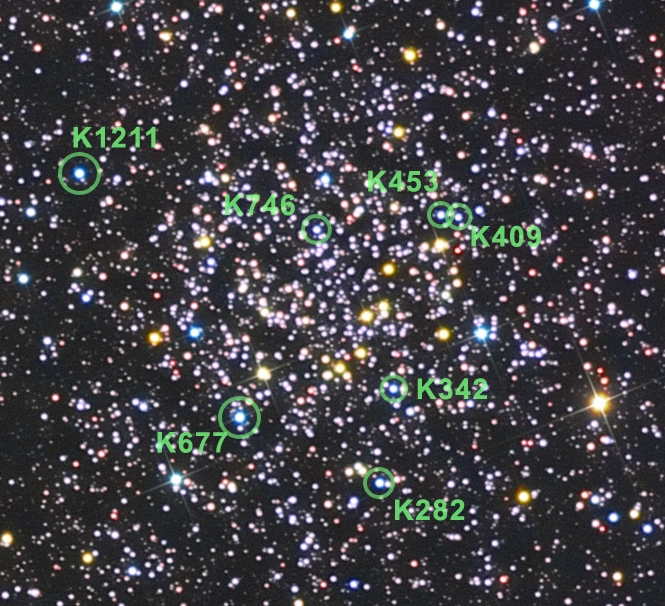
Of course the drawing is not totally precise, nevertheless it can easily be compared to the photographs. Furthermore the MTM Observatory's photo shows beautiful colors of the stars, and the bright blue stars are very easy to locate.
There is the obvious challange to observe the colors of the stars - and the blue stragglers in particular - with own eyes. Knowing their positions one only needs a big enough telescope a crystal clear autumn night free of light pollution and probably a lot of patience. This is still somewhere in the future...
It happened that not much after writing this little article, on the night of February 05. 2016. we took a look at NGC 7789 with a 16" Dobsonian at Ágasvár using 220x magnification. The first test object was the wide "double star" about 1/3 way between K 677 and K 1211, closer to K 677. This pair of bright stars shows a very prominent difference in color: K 899 (to the right in the above photo) is very blue while the red giant K 971 (to the left) is very strongly orange. We have all seen the color difference in the telescope, though it is by far not as spectacular as in the case of gamma Andromedae. Then we took a look at K 677, the brightest blue straggler. Its color was harder to detect but we could see something. The star might seem to be vivid blue in the photo but at such a brightness it seems to be very pale visually. Furthermore there is no red giant very close to K 677 therefore I tried to compare the color with the red giants at the south-west edge of the central part of the cluster (right in the photo).
I would note that this is not a scientific pubication. I tried to present the latest informations I found but I do not follow the literature and I am not a professional astronomer. It might be possible that not everything is totally OK that you can read here.
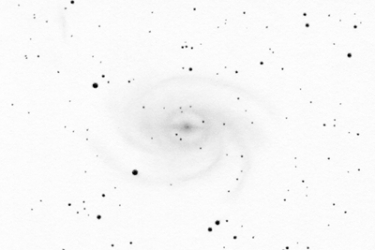
Pavo galaxy
The grand spiral galaxy of Pavo
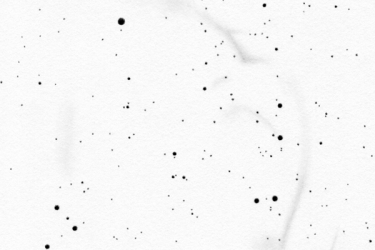
Panorama drawing
Huge and faint supernova remnant in the southern sky
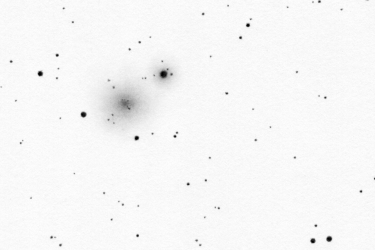
Centaurus globular cluster
The second globular in Centaurus

Apus globular cluster
Globular cluster close to the Southern celestial pole
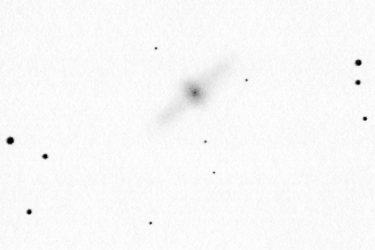
Centaurus galaxy
Polar ring galaxy
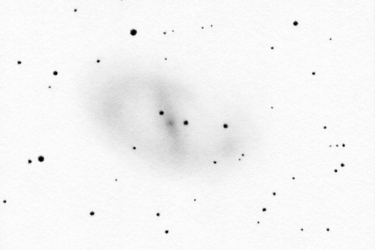
Ara galaxy
Barred spiral galaxy in the thick of the Milky Way